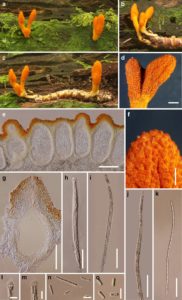Ophiocordyceps formosana (Kobayasi & Shimizu) Wang et al. in Wang et al.,
Evidence: Based Complementary and Alternative Medicine (no. 189891): 4 (2015)
Parasitic in larva of Coleoptera (Superfamily Tenebrionoidea), forming yellow to orange ascostromata. Sexual morph Ascomycetous. Stromata 14 mm long, 2-5 mm wide, growing from the head and the tail of Coleoptera larva, simple or branched, yellow to orange, stipitate. Stipe 1.9–3.7 cm long, 2–4 cm wide, yellow, cylindrical, surface rough. Fertile head 30 mm long, 2–2.5 mm wide, orange, mostly elliptic barely branched, head-like, with orange, pseudoparenchymatous, epidermal tissues, surface mastoid, differentiated from stipe. Ascomata 453–546 × 265–298 μm (x = 479 × 270, n= 30), completely immersed, orange, flask-shaped to oval, with the ostioles opening on the surface of the head. Peridium 26–38 μm wide (x = 30, n = 60), comprising three layers. Asci 366–498× 8–11 μm (x = 437×10, n = 60), 8-spored, hyaline, cylindrical, with apical cap, breaking into secondly ascospores. Secondary ascospores 2–6×1–3μm (x = 4×2, n = 60), hyaline, cylindrical. Asexual morph Undetermined.
Material examined: CHINA. Province of Hunan, on dead larva of Tenebrionoidea, 23 October 2014, Ping Zhang,
ZP8282 (MFLU 15–3888); ZP828i (MFLU 15–3889, MFLU 15–3890, MFLU 15–3891).
Notes: Ophiocordyceps formosana was introduced by Kobayashi (1979) as Cordyceps formosana Kobayasi & Shimizu. Wang et al. (2015a) revised it as Ophiocordyceps formosana. This species is frequently used in Traditional Chinese Medicine and has a long history of use as tonics and folk medicines that can be used as anticancer and diabetes treatments and contains antioxidants (Wang et al. 2015b). This species was previously known from Fujian and Taiwan (Wang et al. 2015b). We collected this species in Hunan Province, China, which is a new record for the province.We also provide a colour figure for this species which includes asci and cap and entire ascospores, which are illustrated for the first time.
Fig. Ophiocordyceps formosana (MFLU 15–3888) a Stromata appearing from the tree b Yellow, superficial stroma
appearing from host head c Overview of the stromata and the host d, f Apical part of the stroma e Vertical section of stroma g Cross section showing the complete perithecia h–j Asci at immature and mature stages k Entire ascospore l, m Asci with apical cap n, o Secondly ascospores. Scale bars: d = 1000 μm, e, f = 200μm, g = 100 μm, h, k=20 μm, i, j = 50 μm, l–o =5 μm.

